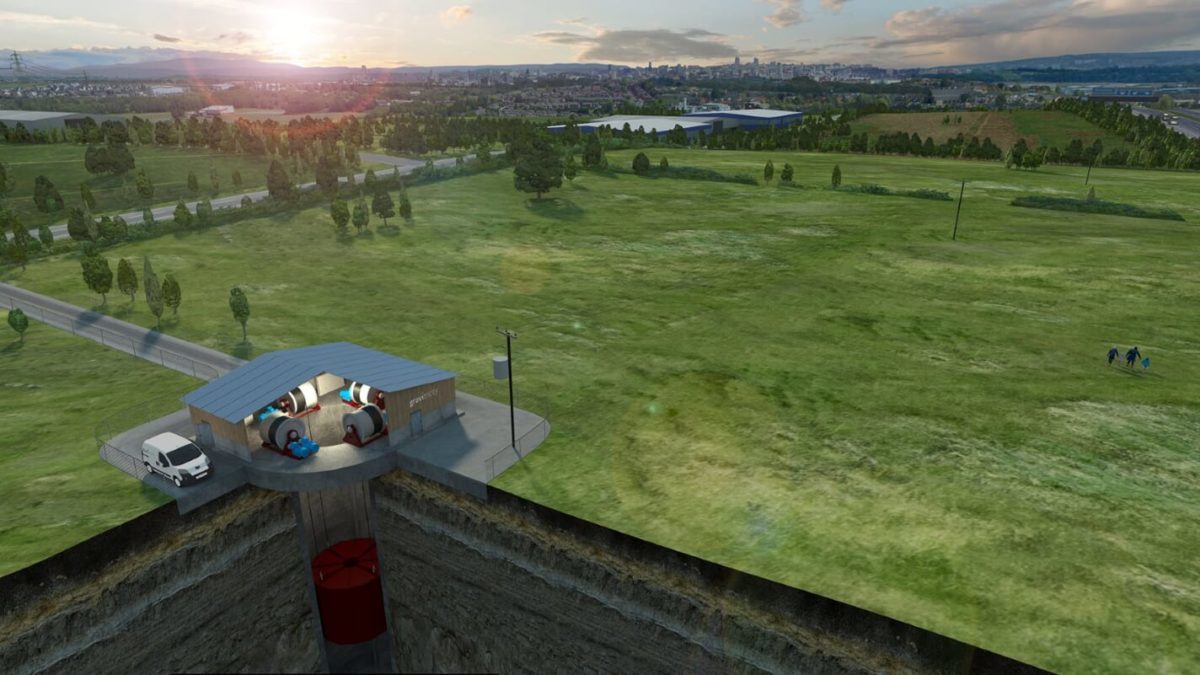Scottish start-up Gravitricity has developed a gravity energy storage system it says is perfect for storing solar and wind power.
A 50-foot-high rig would use wind or solar power to raise a mass in a 500 to 5,000 foot shaft and discharge the electricity that’s been “stored” by releasing the mass to rotate an electric generator.
Gravitricity said the mass used can range from 500 to 5,000 tons and the electricity discharged could power 30,000 nearby homes for two hours.
The start-up claimed sophisticated winches and a control system can lower the mass very quickly, making it flexible enough to stabilize electricity networks at 50 Hz and ensuring the set-up can respond to full power demand in less than a second. “Our technology has the fast response time of lithium-ion batteries,” the company said.
The Edinburgh-based company said the system offers 25-year service without loss of performance or cyclical degradation and can be sited anywhere, including in city centers. The developer pointed to disused mine shafts as ideal locations, however.
Demonstration project
Gravitricity will begin construction of a $1.2 million pilot project in October on an industrial site at Port of Leith, Scotland’s largest enclosed deep-water port.
With completion scheduled for December, the 250 kW prototype will be connected to the port’s power network and have its speed of response for grid stabilization assessed. “The demonstrator at the Port of Leith will allow the technology to be trialed on a much smaller scale, utilizing an above ground structure,” the company said.
The pilot system will use two 25-ton weights suspended by steel cables. “This two-month test program will confirm our modeling and give us valuable data for our first full-scale, 4 MW project, which will commence in 2021,” said Gravitricity lead engineer Miles Franklin.
The lattice tower for the Port of Leith facility will be supplied by U.K. engineer Kelvin Power and the winches and control system will come from Huisman, a Dutch manufacturer of heavy lifting, drilling, pipe laying and mooring systems.
The project is being backed by government agency Innovate UK with a $780,000 grant.
Gravity storage
U.S. company Energy Vault unveiled gravity-based storage technology relying on a crane and 35-ton concrete blocks a year ago. That system was said to take account of volatility in energy supply and demand, weather conditions and inertia, according to its developer, and was backed by a $110 million investment from Japanese lender SoftBank in August. “Energy Vault will be demonstrating the first 35 MWh storage tower, in the north of Italy in 2019,” the Japanese conglomerate announced at the time.
Austrian research organization the International Institute for Applied Systems Analysis (IIASA) last year suggested gravitational energy storage for low-energy-demand locations. In that instance, the technology put forward involved dual cranes on a mountain cliff-edge connected to an energy storage site at the base of the drop plus an electric motor on an upper storage site to transport a solid mass of sand or gravel. IIASA scientists said such a system could be combined with other forms of energy storage and renewables, would cost $50 to $100 per megawatt-hour of stored energy and $1 million to $2 million per megawatt of installed storage capacity to develop.
This content is protected by copyright and may not be reused. If you want to cooperate with us and would like to reuse some of our content, please contact: editors@pv-magazine.com.









Gravitational potential energy is seriously weak, which is why these gravity schemes are unlikely to be cost-effective! 50 tonnes lowered 5000 feet (1524 m) only stores 212 kWh, so factoring in losses this demo system is at most just two Tesla Model S battery packs. And how many mine shafts are actually are a mile deep? The demonstration picture doesn’t even show a hole in the ground, and I doubt there are such deep holes at *Port* Leith.
Gravitricitry claims its production system will lower 500 – 5000 t, which starts to get interesting. But now you have to manage a set of big, bus-sized weights (assuming they’re made of cheap concrete) on the surface and at the bottom. How many mines have a switching railyard at the bottom to move weights in and out of position? You’re still not storing much energy lowering the entire set of weights, so the system has to be completely automated and reliable. Maybe you just empty and fill second-hand railcars at the top and bottom with rubble, with a train moving them under the crane. Not impossible, but it feels as unlikely as Energy Vault’s lego block towers.
If you could make good money raising and lowering weights, property management companies would be loading up their skyscrapers’ elevators at night.